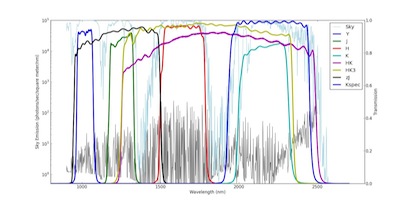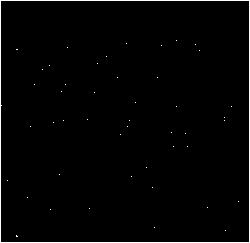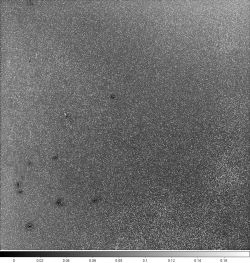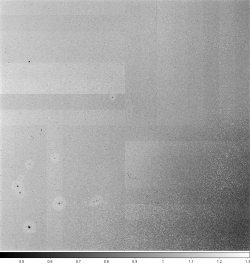| Field-of-view: | 6.9 x 6.9 arcmin |
| Pixel scale: | 0.202 arcsec/pix
(optical layout) |
| Detector: | 2048 x 2048 pix, HgCdTe Hawaii-2 |
| Electronics gain: | 10 e-/DN |
| Read-noise: | 16 e- |
| Full well: | ~230,000 e-, or 23,000 DN |
| Linearity: |
Linearity correction is required; usable to 20,500 DN (90% of full well).
|
| Dark current: | 0.05 e-/s/pix at 83 K (depends on final operating temperature). |
| Readout: | 32 channels at 180 kHz; 0.7 sec for a single read. |
| Data Acquisition Strategy: |
The HAWAII-2 is a CMOS device that reads non-destructively. Thus there is no shutter.
Images are obtained by differencing a pair of reads N seconds apart ("double-correlated sampling"),
or, better, by taking multiple reads and then fitting a linear slope to each pixel ("up-the-ramp
sampling"). Up-the-ramp sampling can measure count rates for pixels that saturate or have cosmic
rays hits during an exposure.
|
| Exposure times: | Must be integer seconds >= 1 sec. |
| Filters: |
Y (data),
J (data),
H (data),
K (data),
and a Dark position. |
| Focus: | Provided by wavefront sensor; f/5 focus changes on ~10 minute
time-scales at the MMT. |
| Sky Background: | Dominated by narrow OH emission lines and broad H2O absorption bands
(additional discussion). |
| Readout overhead: | 5 sec total overhead per exposure, including 30 arcsec telescope dither. |
| Guiding: | Images are unguided. |
| Observing Strategy: |
Long integrations are made from a series of short exposures, otherwise the night sky
quickly saturates the detector (see Imaging Senstivity table). Images are obtained in a dither sequence. Sky background is measured, and removed, by
median-combining a set of dithered images. This works well for sparse fields and point sources,
however observations of extended objects require dithering on an OFF field to measure the sky
background. Worked example.
|
| Full field for Spectroscopy: | 4 x 6.8 arcmin |
| Field for Complete Spectra: | 2 x 6.8 arcmin |
| Number of slitlets: | Up to 40 slitlets, assuming a minimum length of 10 arcsec |
| Long Slits available: | 420 x 0.2, 0.4, 0.6, 0.8, 1.2, 1.6, 2.4 arcsec |
| Dispersed spectrum: | Approx 1400 pixels long, with the available grisms |
| Calibration lamps: | Continuum, Argon |
| Telluric calibration: | Bright G dwarf stars |
| Observing Strategy: | Similar strategy as imaging, except that the target(s)
must be dithered along the slit(lets). Exposure times can be much longer because the sky
background is dispersed. In addition, argon lamp exposures are required at each pointing to
perform wavelegth calibration. To remove telluric observation lines, observe a bright G dwarf
star at identical airmass. |




